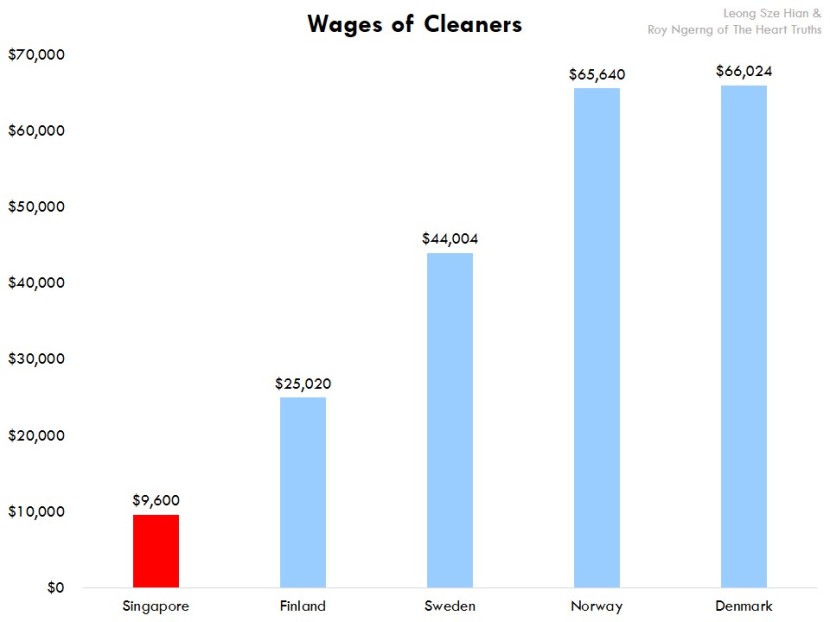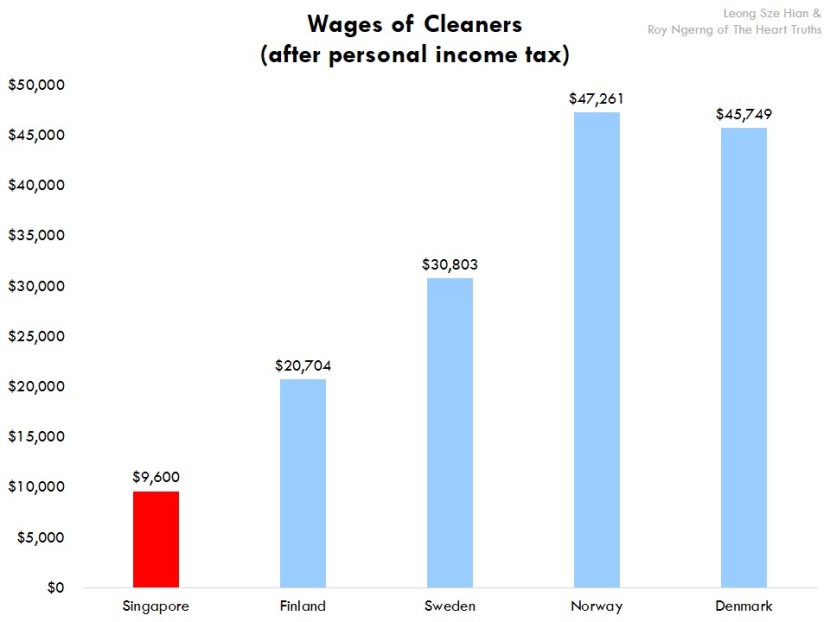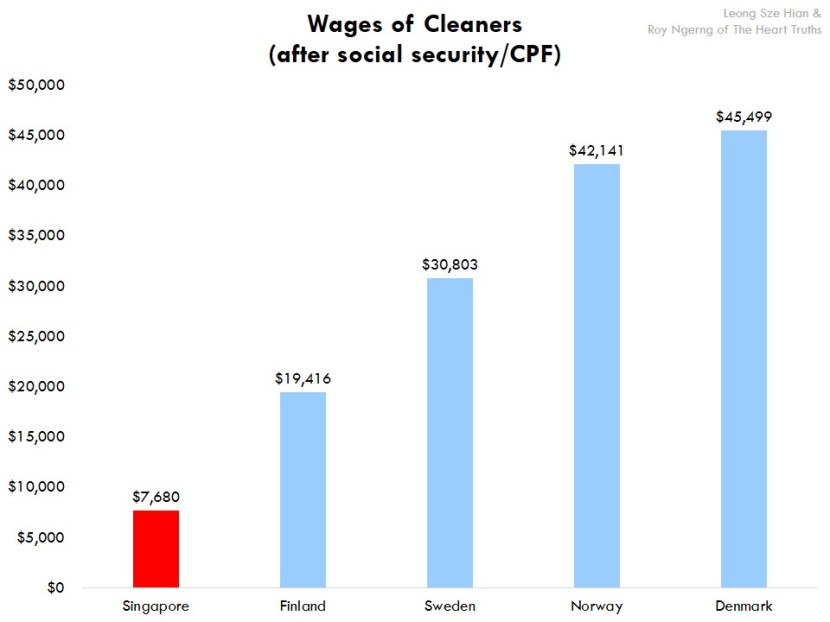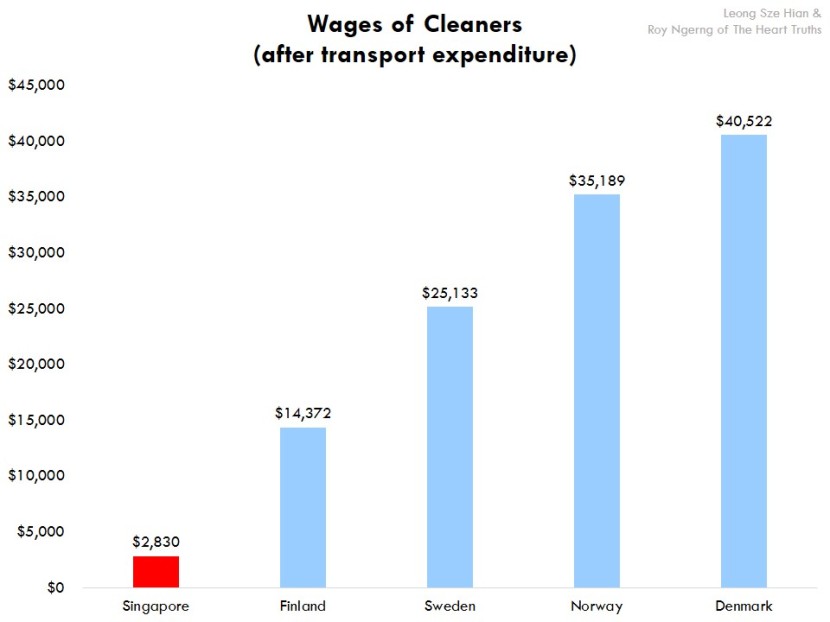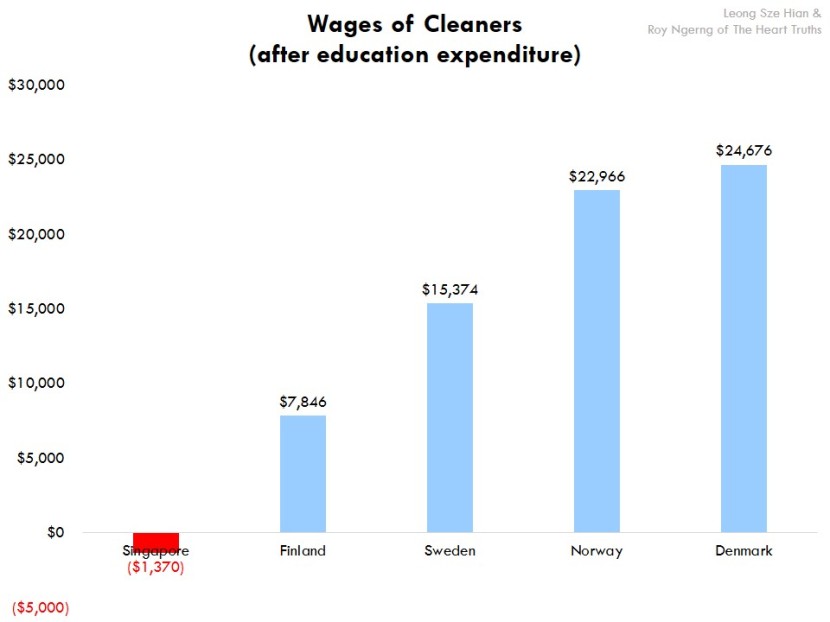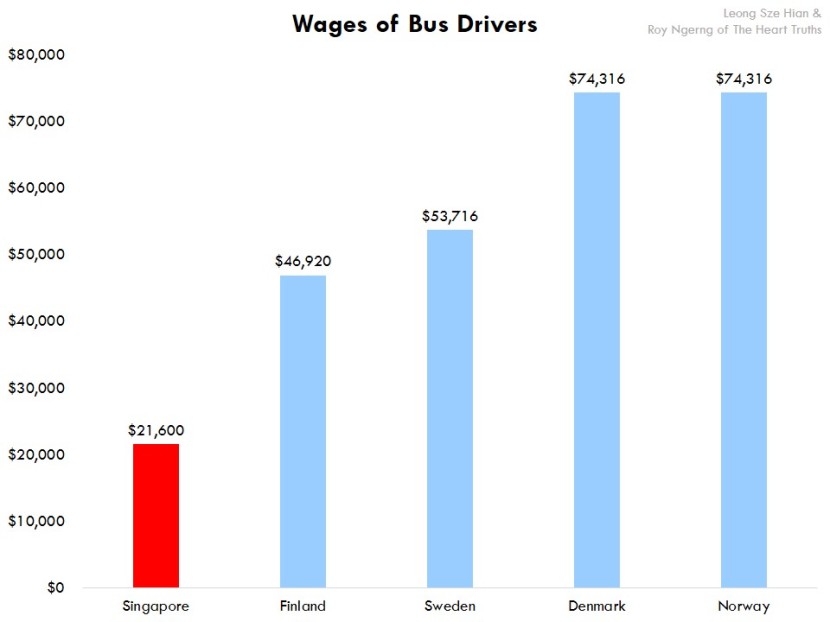By Roy Ngerng and Leong Sze Hian
This is a 10-part series which will analyse the tax that Singaporeans are paying, in comparison with the Nordic countries. It has been said that Singaporeans pay one of the lowest taxes in the world, and that the Nordic countries pay one of the highest taxes in the world. This series would explore this matter in greater depth, and seek to have a better understanding of what the truth really is.
In brief:
- Low- and middle-income Singaporeans are not able to save and retire in Singapore. Even though taxes are higher in the Nordic countries, because wages are also a lot higher, low-income citizens in the Nordic countries would still be able to save and retire.
Singaporeans have been often told that tax rates are low in Singapore and thus more cannot be done for Singaporeans.
But for the poor in Singapore, are they really paying the lowest taxes? And also, are they “less badly off than if you were poor nearly anywhere else in the world,” as the Singapore prime minister had claimed?
Let’s take a look. In this article, we will compare how much citizens in each of these countries have left to save, after taxes and spending on their basic needs.
In December last year, we wrote an article comparing the wages of low-wage workers in Singapore with that of the Nordic countries. We looked specifically at the wages of cleaners and bus drivers, as quoted by Professor Tommy Koh.
Today, we will look at their wages in more detail.
In Chart 1, you can see the annual wages of cleaners in Singapore (not inclusive of bonuses), as compared with that of the Nordic countries.
Chart 1: The Straits Times Singapolitics What Singapore can learn from Europe
You can see that the cleaners in Singapore earn the lowest wages, as compared to the Nordic countries. In fact, the cleaners in Norway earn nearly 7 times what Singaporeans earn.
We have also been told that taxes in the Nordic countries are one of the highest in the world.
Actually, for the poor in Singapore, and not only that, but also in Norway and as well, they are not required to pay taxes. For the poor in Finland, they have to pay about 17.25%, and in Sweden and Denmark, they would have to pay about 30% of their wages into tax.
In Chart 2, you will see how much wages cleaners have after tax in each of the countries.
Chart 2
You can see that the wages of the cleaners in the Nordic countries are still higher than Singapore, even after tax deduction. We have been told that because tax is high in the Nordic countries, their wages get reduced significantly. However, you can see that this is not true. In fact, they still have higher wages than Singaporeans.
But what about after deducting for Central Provident Fund (CPF), or social security? This is where it gets interesting. Low-wage workers in Singapore might pay one of the lowest taxes in the world, but we actually pay the highest CPF, or social security rate in the world – we pay 20%, as compared to 5.15% in Finland, 7% in Sweden and 7.8% in Norway. People in Denmark pay a flat rate of $250.
But actually, we are paying 36% because if employers don’t have to contribute the employer CPF contribution of 16%, Singaporeans would arguably be paid higher wages. For the purpose of this article, we will use 20% for the analysis.
After deducting for CPF/social security, you can see Singapore still have the lowest wages. For Sweden, the social security rate is already included under the personal income tax rate in Chart 2 (Chart 3)!
Chart 3
Next, let’s take a look at spending on the basic necessities – food, transport, housing, healthcare and education.
For food, we worked with the assumption that a low-wage worker in Singapore would spend only $10 on food everyday, which would make an annual $3,650 on food. According to Numbeo, food prices are 11.6% more expensive in Sweden than in Singapore, 12.1% more expensive in Finland, 16.6% more expensive in Denmark and 55% more expensive in Norway. Thus food prices in the Nordic countries would be $4,074, $4,092, $4,256 and $5,657 respectively.
After deducting for expenditure for food, Chart 4 would show how much a cleaner would have left.
Chart 4
Very interestingly, the gap widens further again. Even though food in the Nordic countries is more expensive, after spending on food, the Norwegians would now have more than 9 times what Singaporeans would have. This is because in Norway, cleaners have much a much higher starting wage, which would give them a higher purchasing power.
Next, we look at transport. For a Singaporean, we assume that he/she spends $100 for travel every month or $1,200 annually. In the Nordic countries, citizens are able to travel on travel passes, which offer huge discounts and subsidies for travel. Thus the Danish would need to spend only $722, the Finns $951, the Swedes $1,597 and the Norwegians $1,295 – pretty much the same as how much Singaporeans would spend.
Chart 5 shows you how much citizens in each country after deducting for transport costs.
Chart 5
This time, again the gap widens – the Norwegians have 12 times more what a Singaporean would have! Do you see the trend here? With every deduction, the Singaporeans earns significantly lesser and lesser, comparatively. Why is this the case? First, Singaporeans earn a much lower wage than people in the Nordic countries. Second, even though costs might be more expensive in the Nordic countries or in some instances the same as Singapore, but because they have higher wages, the costs take up a much lower proportion of their wages.
We next move on to housing. How much will Singaporeans have after deducting for housing?
For the lowest-income earners in Singapore, they would be able to rent public flats from the Housing Development Board (HDB), for between $26 to $275. For this discussion, we will use the midway point of about $100 for comparison. A person would thus need to pay $1,200 in rental in a year.
Similarly, for the lower-income who buys a 2-room HDB BTO flat for about $100,000, with $20,000 CPF, the maximum housing grant of $60,000 and a 25-year HDB loan of $20,000, the monthly mortgage repayment is $91.
However, how many people who buy a 2-room flat actually qualified for the housing grants, and for those who could qualify, how much was the quantum of the grant? How many Singaporeans actually qualified for the maximum $60,000 grant, which the HDB had shown in illustrations to show that HDB flats are affordable?
For the Nordic countries, according to the OECD Better Life Index, the Norwegians would spend 18% of their income on housing, the Swedes 21%, Finns 22% and Danish 24%.
Chart 6 shows how much they have after deducting for housing.
Chart 6
Singaporeans will only have $1,630 left in one year, after spending for housing. Meanwhile, the gap between the Norwegians and Singaporeans widens further – the Norwegians would have nearly 14 times what Singaporeans would have left.
But there is still healthcare and education!
Moving on to health, according to Worker’s Party Gerald Giam, in 2012, there were “over 2,400 MediShield policyholders made co-payments of over $10,000 each”. For this illustration, we will look at what happens if we assume that a Singaporean would have to pay $1,000 cash for his medical bills (assuming that his Medisave is enough to pay for most of his co-payments and that Medisave cannot be used for things like out-patient treatment other than the approved list of chronic illnesses, etc). For those who cannot pay, they can apply for Medifund in theory. However, as we understand it, in order to get Medifund to pay the entire bill, the patient must be in Class C, all family members’ Medisave must be wiped out, he/she cannot be staying in a private property, cannot have more than a few thousand dollars in the bank, etc.
However, for the people in the Nordic countries, they do not need to pay hefty healthcare bills. The governments in the Nordic countries provide very heavily subsidised bills. Also, in these countries, there is only a cap, or maximum amount that the citizens need to pay for healthcare. The Danish get healthcare for free. Norwegians only need to pay a maximum of $407 every year. For the Swedes, this is $518 and for the Finns, the maximum they need to pay is $1,022.
So, after deducting for healthcare, what do we get? You would remember that for the Singaporean, he/she had only $1,630 left previously. And because he/she would still need to fork out $1,000 in cash for his medical bills, the Singaporean is thus left with a surplus of $630. In other words, a Singaporean low-wage worker would have very little left. However, for the citizens in the Nordic countries, they would still be in good financial health (Chart 7).
Chart 7
Finally, on education – assuming the Singaporean has two children, one in university and one in a polytechnic. The lowest university course fees are $7,650 and the lowest for a polytechnic course is $2,300. Assuming the children are able to receive bursaries, the polytechnic student would still need to pay about 20% of the fees. Also, the parent would still need to pay the non-tuition expenses of say about $2,000 in a year for their education.
However, in the Nordic countries, education is free. As such, in the Nordic countries, parents do not have to spend anymore for their children’s education, or even for their own further education.
Thus finally, what you would see is that after deducting for tax, social security (CPF) and the essential spending on basic services, citizens who work as cleaners in the Nordic countries would be able to save between $7,846 and $24,676 in a year. However, for a Singaporean, he/she would go into a debt of $1,370 (Chart 8).
Chart 8
This means that for a Singaporean on low-income, he/she has two options. Either they take on loans and go into further debt, or they would have to choose to forgo seeking treatment for their medical condition, and they might not be able to put their children through higher education.
Thus, even though tax is low in Singapore, does it actually benefit Singaporeans, especially low-wage Singaporeans? For citizens in the Nordic countries, they receive next to free healthcare and free education. Thus if they fall ill or would like to further upgrade themselves by studying, they can do so with ease of mind. However, for a Singaporean, the debt burden would put them off these pursuits. They would end up being sicker and their health condition might worsen. And if their children are not able to go to universities or polytechnics, they would remain poor.
Thus, the question is – would paying higher taxes and receiving free healthcare and education be worth it? The answer seems to be a yes, from the example of the Nordic countries.
However, you might ask – but what about someone who earns a higher income? We had also looked at the wages of bus drivers, and compared them with that of the Nordic countries. You can see the wages of the bus drivers in the different countries in Chart 9. For the Singaporean, he/she would earn $1,800.
Chart 9: The Straits Times Singapolitics What Singapore can learn from Europe
The difference in calculation would be that instead of spending $10 everyday on food, a bus driver in Singapore might be able to spend $15 on food. For housing, he/she wouldn’t be able to apply for subsidised rental flats with the HDB, and would pay about $650 to rent a flat.
After deducting for the expenses, a Singaporean who earns $1,800 would still go into a debt of $217, whereas counterparts in the Nordic countries would still be able to save between $17,977 and $43,532 in a year (Chart 10).
Chart 10: The Straits Times Singapolitics What Singapore can learn from Europe
Now, consider this – if a Singaporean who earns $1,800 would still go into debt, this means that about 35% of the population cannot save, and are not paid enough wages to do so! But, how much must a Singaporean earn in order not to have to go into debt, and barely survive?
Thus you see, the governments in the Nordic countries are paying their workers a wage that is commensurate to the cost of living in their countries. We had previously written about how Singapore is the 6th costliest city to live in, in the world, whereas all the capital cities in the Nordic countries are cheaper to live in. Oslo, Norway is 18th most expensive, Copenhagen, Denmark is 21st; Stockholm, Sweden is 46th and Helsinki, Finland is 65th. As such, if their citizens are earning higher wages, shouldn’t Singaporeans be earning higher wages as well, and even higher wages than them since our cost of living is even higher?
Not only that, because the governments in the Nordic countries collects more tax and redistributes them, for the poor in these countries, they are able to continue to access basic services and yet, be able to save as well. This is a luxury that the poor in Singapore cannot afford. Instead, the poor in Singapore has to suffer from poor health and lost educational opportunities.
In the next part of the article, we will share with you how much of the share of income in Singapore the poorest 80% of Singaporeans have, and how much the share of income the richest 20% hold. What you will find out might shock you even further.
This article was first published in The Heart Truth
